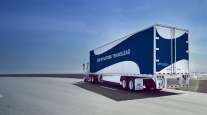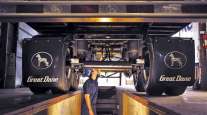Flatbed Manufacturers Introduce New Models as Demand Picks Up After Prolonged Recession
By Mindy Long, Special to Transport Topics
This story appears in the Aug. 12 print edition of Transport Topics.
Manufacturers of flatbed trailers say they are increasing production and rolling out new models to help haulers meet their customers’ rising demands as business picks up following the prolonged economic recession.
The industry estimates 26,000 flatbeds will be produced in 2013, an 8.3% increase from the 24,000 produced in 2012, said Keith Limback, general sales manager for Manac Trailers in Freeport, Pa., citing data from ACT Research Co. and FTR Associates. Those totals are a significant increase from 2009, when just 7,000 were produced, he added.
According to Specialty Transportation.net, manufacturers sold 24,100 flatbeds in 2012. Fontaine Trailer Co. was the market leader, selling 20.6% of the units, followed by Wabash National Corp. (12.9%), Utility Trailer Manufacturing Co. (12.2%) and Reitnouer Inc. (11.4%). None of the other flatbed makers was in double digits.
In 2012, a total of 234,870 trailer units were sold, a 9% increase from 2011’s total of 214,634. Wabash National was the leader with 19.4% of market share. Utility ranked third at 16%, Fontaine was eighth at 2.6, and Reitnouer was 14th at 1.2%, according to Trailer/Body Builders magazine.
In a report released earlier this year, Specialty Transportation researchers said, “STN estimates indicate demand for [flatbed] trailers will remain moderate in 2013 [after above-average increases in 2011 and 2012], buoyed by the need to replace an aging fleet and supported by a modest uptick in construction activity, and is likely to pick up substantially in 2014, once the anticipated recovery in the housing segment sets in.”
Those interviewed by Transport Topics concurred.
Rick Walker, president of Walker’s Trailer Sales in La Vergne, Tenn., said, “In our region, housing and new construction is picking up, which means business is picking up for the lumber industry, the shingle haulers and steel haulers.”
Walker, whose flatbeds include those made by Fontaine and Doonan Specialized Trailer, also said he is seeing a steady increase in flatbed sales, with year-over-year increases of 15% to 20%.
Fontaine and Doonan did not respond to requests for comment.
But Brian Gast, president of E.W. Wylie Corp., a flatbed and specialized hauler in West Fargo, N.D., said some areas of the economy tend to pick up for a certain amount of time, then they recede and something else picks up.
“It is like playing whack-a-mole,” Gast said. “You have to chase the segments that are strong at the moment.”
Nonetheless, the predicted rise in the flatbed market recently has led one trailer maker to add flatbeds to its product line and others to offer new models.
Officials at San Diego-based Hyundai Translead started researching the flatbed segment during the worst of the recession, hoping to take advantage of the sales spike that was sure to come, said Chris Lee, vice president of engineering for the company.
This will be Hyundai’s first full year of flatbed production, which the company said would include 10 different models.
“We did extensive research before we launched them, and we see a tremendous amount of opportunity,” Lee said. “We expected the industry to come back and the flatbed business to grow — and it did.”
Lee said he expects the flatbed market to remain strong.
“It is a lot of replacement equipment now, but we see in the future the companies who operate flatbed will expand as the economy picks up and grows. We also feel that there is a lot more equipment out there that needs to be replaced because it is an aging fleet,” he said.
Hyundai Translead ranked No. 4 in the overall trailer manufacturing market in 2012 at 10.9%, according to Trailer/Body Builders.
Rick Klein, general manager of Cadiz, Ky.-based Transcraft Corp., a subsidiary of Wabash National Corp., said this is a good time for trailer makers. “As the economy continues to strengthen, construction continues to increase and housing starts accelerate, there is opportunity for manufacturers, dealers and carriers in the flatbed market,”
What’s more, the industry lost many smaller flatbed carriers during the recession, which will create new opportunities, said Keith Monroe, director of platform trailer sales for Chicago-based Great Dane Trailers Inc.
Added William McKenzie, director of dealer development for East Manufacturing Corp, Randolph, Ohio: “With the market being soft, it allows you the time to focus on being more diversified and branch out instead of being covered up with what you normally do.”
Not only are carriers purchasing flatbeds, they’re looking for them to do more — and manufacturers are responding.
“A lot of the opportunity here is about increasing the overall efficiency of the flatbed product,” Klein said. “The more versatile the trailer, the faster the driver can secure the load and get back in the truck.”
Transcraft introduced three new flatbed models this year and three in 2012.
East Manufacturing’s McKenzie said drop-deck trailer sales are increasing as well “because the customer is trying to diversify. A typical flatbed is 65 inches off the ground. Now you can go to one that is 35 inches off the ground and you can haul that taller machinery.”
At E.W. Wylie Corp., the majority of step decks are low-profile models at 34 inches.
“It gives us the flexibility to haul building materials, pipe and equipment using the same drivers,” Gast said. “If you can service the different types of markets with the same equipment, you’re a whole lot better off.”
Walker, the dealership president, said some carriers are buying drop decks, then installing load-leveler systems, which use ramps that store on the side of a trailer and can be deployed so carriers can haul a regular flatbed load.
Lenny Miller, flatbed product manager for MAC Trailer Manufacturing in Alliance, Ohio, also is seeing more fleets invest in drop decks. He said MAC, which builds only aluminum trailers, uses a special heat-treated manufacturing process that increases the weight capacity the company’s drop decks can haul.
“We have built drop decks that are hauling 60,000- to 90,000-pound loads,” he said.
Carriers said they’re also increasing versatility by moving to 53-foot flatbeds from 48-foot units.
Dan Wirkkala, president of Smokey Point Distributing Inc., a less-than-truckload flatbed carrier based in Arlington, Wash., told Transport Topics there has been a “definite shift” to the longer trailers by his customers.
“Shippers are looking to add more length and get more bang for their buck,” he said.
Wirkkala also said Smokey Point Distributing has added 53-foot flatbeds with extendable decks to its fleet.
Melton Truck Lines, based in Tulsa, Okla., has converted half of its fleet to 53-foot flatbeds.
“A lot of our customer base cubes out before it weighs out. Having an additional 5 feet allows us to satisfy and placate those customers,” company President Bob Peterson said. “Every year, we trade out 48 and buy 53s. In a matter of years, we’ll be 100% 53s.”
Manac’s Limback said increased machinery exports have contributed to the 53-foot trend.
“As the U.S. dollar is weak, we became better exporters, so a lot of farm and construction machinery had to be moved to shipping ports,” he said.
E.W. Wylie has been converting most of its fleet to 53-foot trailers but still retains some 48-footers.
“On the heavy equipment side or the agricultural or farm side, most of the manufacturers are requesting the 53-foot product because they can get more pieces on that trailer,” Gast said.
However, haulers of lumber or drywall want the shorter trailers.
Some carriers are looking for even longer units. Manac makes extendable flatbeds, and Limback said those sales are increasing. The 48-foot extendable opens to 80 feet and the 53-footer opens to 90.
This year, MAC introduced a 53-foot trailer that extends to 63 feet.
Great Dane’s Monroe said the trend to 53-foot units will have a positive effect on sales of aluminum flatbeds, which are lighter than all-steel or steel-and-aluminum combo trailers.
According to Monroe, all-aluminum flatbeds are gaining market share and are now 25% of the total market.
Manac’s Limback said that the number of housing starts bodes well for the aluminum segment.
Manufacturers said aluminum trailers can reduce trailer weight by 1,500 to 2,000 pounds. An all-aluminum trailer costs about $10,000 to $12,000 more than an all-steel version.
McKenzie said all-aluminum flatbeds maintain a higher residual value.
However, some carriers aren’t willing to make the additional investment in all-aluminum flat-beds. Peterson said Melton Truck Lines uses steel-and-aluminum combination trailers.
He said all-aluminum trailers “are worth more on a residual basis, but we can’t justify the increased cost.”
Wirkkala said Smokey Point hasn’t switched to all-aluminum trailers yet but may consider them in the future.
Lee said Hyundai Translead’s engineers are looking at different materials and different grades of steel that could reduce weight “while not sacrificing any structural integrity.”
Manufacturers continue to look for innovations, and new technology can help them bring products to market faster. Klein said Transcraft for the past 18 months has been rolling out 3-D modeling software packages that allow engineers to meet customer expectations and requirements in less time.
“It allows the engineer to completely manipulate the product he is designing and enhances certain areas of the design,” Klein said.
But shippers aren’t the only ones placing demands on flatbed manufacturers. Government regulations also are forcing OEMs to improve their products.
Ed Chambless, manager of the curtainside/flatbed products division at Utility Trailer Manufacturing in City of Industry, Calif., said flatbed carriers are being more specific with load-securement procedures for particular products, some of which are driven by regulations.
“A few months ago, Alabama came up with a specific regulation that drivers have to be certified to secure and drive with coil steel loads,” Chambless said, adding that he expects more state, city and county regulations to follow.




